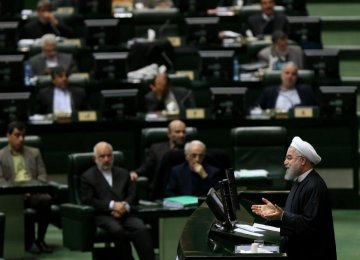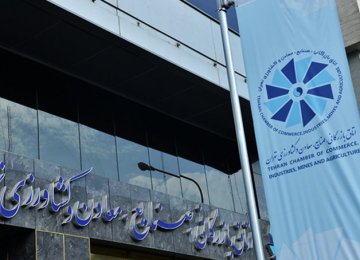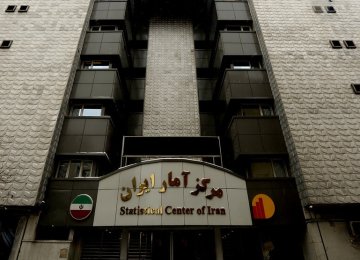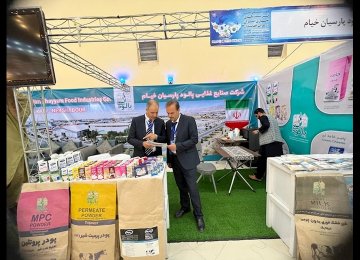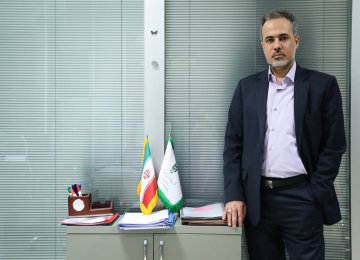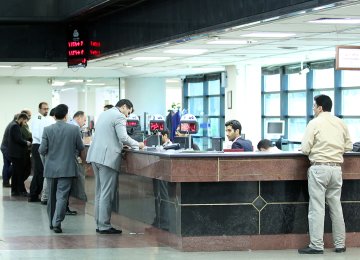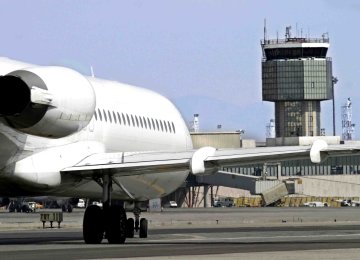President Hassan Rouhani submitted the drafts of the budget for the upcoming Iranian fiscal year and Iran’s sixth five-year development plan (2016-21) to the parliament on Sunday, hours after sanctions on Iran’s economy were lifted.
The draft budget for the Iranian fiscal year starting on March 20 is expansionary and less reliant on oil revenues, but with an eye on foreign investment.
The budget responds to weak domestic consumer demand, falling crude oil prices and the lifting of sanctions that allow Iran to get back into global trade.
Iran’s years of economic isolation ended on Saturday, when world powers lifted the crippling sanctions on Saturday in return for Tehran complying with a deal to limit its nuclear program.
The government’s general budget, not including state-owned enterprises, totals 2,670 trillion rials ($73.3 billion at market exchange rate). This is a 13.1% increase compared to the year before in rial terms. Iran’s budget for the current year stood at 2,360 trillion rials ($64.8 billion).
Iran also separately budgets some 6,817 trillion rials ($187.2 billion) for hundreds of government banks and companies.
President Rouhani also presented the sixth plan’s draft along with the budget. The plan outlines the Iranian government’s strategy until March 2021 to reach an 8% annual economic growth target.
“Iran needs foreign investments of $30 billion to $50 billion to achieve its 8% annual growth target,” he said.
Leader of the Islamic Revolution Ayatollah Seyyed Ali Khamenei announced the general policies of the sixth plan in a letter to President Rouhani early July.
Less Crude Dependence
Reliance on crude oil has been trimmed in line with the continuing plunge in crude oil price.
Oil revenues will make up less than 25% of the proposed budget, down from 33% in the preceding budget. However, the government expects to make 17% more than this year through rial’s weakening and the rise in crude output. Crude oil sales are predicted to hit 660 trillion rials ($18.1 billion at market exchange rate), albeit at the government exchange rate which is 21.5% stronger than the current market rate.
The Rouhani administration has based its oil revenues on selling its crude at $35 to $40 per barrel. This is while Benchmark Brent crude closed below $29 a barrel on Friday and may fall further as Iran has pledged to raise its supply after sanctions are lifted.
The considerably higher than market oil price listed in the budget, coupled with expectation that oil will fall to $20 per barrel has fueled worries that the government will fall short of its expected income and run a deficit.
Government spokesperson, Mohammad Baqer Nobakht, earlier confirmed this scenario for next year.
The government ran a 500-trillion-rial ($13.7 billion) deficit in the first half of the current fiscal year, a source told Financial Tribune on condition of anonymity.
The government also expects a 15% rise in non-oil exports to help cover foreign exchange needs.
“We are resolute in raising non-oil export’s growth rate exponentially,” said the president.
Furthermore, taxes are projected to rise 1,010 trillion rials ($27.7 billion) for the year, up a lofty 17.3% from the prior budget’s 861 trillion rials ($23.6 billion).
The president also said the government will use up to $50 billion in foreign financing to further stimulate the economy.
Huge Rift With Market Realities
The budget is based on a nominally weaker rial versus the dollar. The government exchange rate for every dollar is up 5.1% to 29,970 rials from the 28,500-rial rate of last year.
The budget exchange rate shows a huge rift with market realities.
The greenback traded at 36,400 rials in Tehran’s currency markets on Sunday. However, the stronger budget rate does not mean the government is going to squander its precious foreign reserves to strengthen the rial. It is merely used for budget calculations and has little value beyond that.
The Rouhani Administration has already pointed out that it will use the central bank’s average exchange rate—currently at 30,178 rials per greenback—for its dealings.
Central Bank’s Job
This exchange rate confusion is not going to last long if Central Bank of Iran Governor Valiollah Seif lives up to his promise to abandon the current multiple foreign exchange rate regime in favor of a market hinged managed float, within six months of the lifting of sanctions.
The central bank has its work cut out for next year. Other than overhauling the foreign exchange market, it has to expand money supply while keeping inflation at bay.
The bank is tasked with bringing down interest rates via direct intervention in the interbank market and cutting reserve requirements.
Late as Intended
The budget comes 42 days behind schedule, leaving the parliament little time to review it.
President Rouhani said he chose to delay the budget until after sanctions on Iran were lifted.
The government had drafted the budget on the premises of complete removal of sanctions, as it anticipated. But due to the international sensitivity of the issue, it did not want to let this on before the relief came.
The president added that the government also could not draft a budget on the grounds of continuing sanctions, as that would contradict government predictions.
He told the parliament the deal was a “turning point” for the economy of Iran–a major oil producer that has been virtually shut out of international markets for the past five years.
“Golden Page”
President Rouhani hailed the nuclear deal with world powers as a “golden page” in Iran’s history and looked forward to an economic future less dependent on oil, as the country emerges from years of sanctions and isolation.
Tens of billions of dollars’ worth of Iranian assets will now be unfrozen and global companies that have been barred from doing business here will be able to exploit a market hungry for everything from automobiles to airplane parts.
The International Atomic Energy Agency ruled on Saturday that Iran had abided by an agreement last year with world powers to curb its nuclear program, triggering the end of sanctions.
Minutes after the IAEA’s ruling, the United States formally lifted banking, steel, shipping and other sanctions on Iran. The European Union likewise ended all nuclear-related economic and financial sanctions against the country.
The IAEA’s confirmation that Iran had fulfilled its commitments under the nuclear deal also automatically ended most United Nations sanctions on the country.



